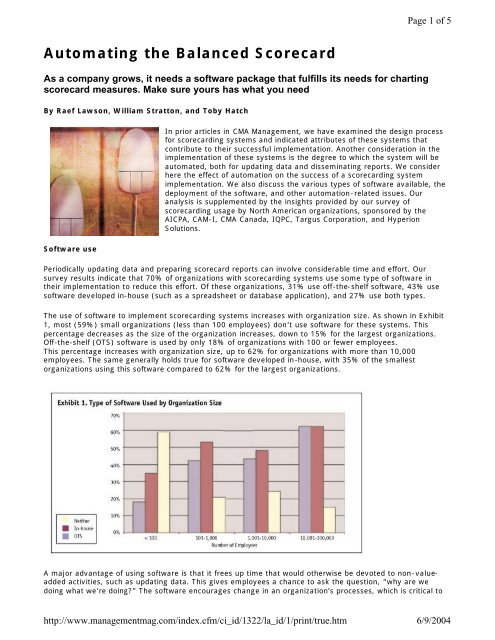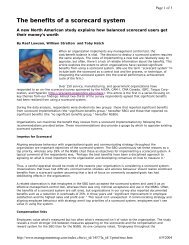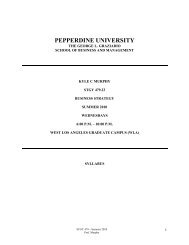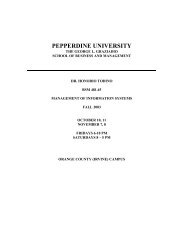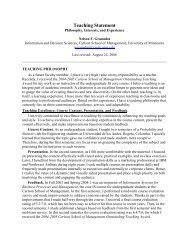Automating the Balanced Scorecard - Pepperdine University
Automating the Balanced Scorecard - Pepperdine University
Automating the Balanced Scorecard - Pepperdine University
Create successful ePaper yourself
Turn your PDF publications into a flip-book with our unique Google optimized e-Paper software.
Page 1 of 5<br />
<strong>Automating</strong> <strong>the</strong> <strong>Balanced</strong> <strong>Scorecard</strong><br />
As a company grows, it needs a software package that fulfills its needs for charting<br />
scorecard measures. Make sure yours has what you need<br />
By Raef Lawson, William Stratton, and Toby Hatch<br />
In prior articles in CMA Management, we have examined <strong>the</strong> design process<br />
for scorecarding systems and indicated attributes of <strong>the</strong>se systems that<br />
contribute to <strong>the</strong>ir successful implementation. Ano<strong>the</strong>r consideration in <strong>the</strong><br />
implementation of <strong>the</strong>se systems is <strong>the</strong> degree to which <strong>the</strong> system will be<br />
automated, both for updating data and disseminating reports. We consider<br />
here <strong>the</strong> effect of automation on <strong>the</strong> success of a scorecarding system<br />
implementation. We also discuss <strong>the</strong> various types of software available, <strong>the</strong><br />
deployment of <strong>the</strong> software, and o<strong>the</strong>r automation-related issues. Our<br />
analysis is supplemented by <strong>the</strong> insights provided by our survey of<br />
scorecarding usage by North American organizations, sponsored by <strong>the</strong><br />
AICPA, CAM-I, CMA Canada, IQPC, Targus Corporation, and Hyperion<br />
Solutions.<br />
Software use<br />
Periodically updating data and preparing scorecard reports can involve considerable time and effort. Our<br />
survey results indicate that 70% of organizations with scorecarding systems use some type of software in<br />
<strong>the</strong>ir implementation to reduce this effort. Of <strong>the</strong>se organizations, 31% use off-<strong>the</strong>-shelf software, 43% use<br />
software developed in-house (such as a spreadsheet or database application), and 27% use both types.<br />
The use of software to implement scorecarding systems increases with organization size. As shown in Exhibit<br />
1, most (59%) small organizations (less than 100 employees) don’t use software for <strong>the</strong>se systems. This<br />
percentage decreases as <strong>the</strong> size of <strong>the</strong> organization increases, down to 15% for <strong>the</strong> largest organizations.<br />
Off-<strong>the</strong>-shelf (OTS) software is used by only 18% of organizations with 100 or fewer employees.<br />
This percentage increases with organization size, up to 62% for organizations with more than 10,000<br />
employees. The same generally holds true for software developed in-house, with 35% of <strong>the</strong> smallest<br />
organizations using this software compared to 62% for <strong>the</strong> largest organizations.<br />
A major advantage of using software is that it frees up time that would o<strong>the</strong>rwise be devoted to non-valueadded<br />
activities, such as updating data. This gives employees a chance to ask <strong>the</strong> question, “why are we<br />
doing what we’re doing?” The software encourages change in an organization’s processes, which is critical to<br />
http://www.managementmag.com/index.cfm/ci_id/1322/la_id/1/print/true.htm<br />
6/9/2004
Page 2 of 5<br />
performance improvement. Our survey results support this idea: organizations that use in-house developed<br />
software report greater benefits from <strong>the</strong>ir scorecarding systems than those that don’t use software.<br />
When implementing scorecarding systems, organizations may start out with a relatively simple system. Many<br />
use a manual system initially; o<strong>the</strong>rs use a series of spreadsheets. As <strong>the</strong>ir scorecarding expertise growths,<br />
and as <strong>the</strong>y become more secure in <strong>the</strong> knowledge that this isn’t a flavour-of-<strong>the</strong>-month management tool<br />
that may go away, <strong>the</strong>y become disenchanted with <strong>the</strong> limits of <strong>the</strong>ir simple systems, and <strong>the</strong>y migrate to <strong>the</strong><br />
more sophisticated systems needed for <strong>the</strong> on-going success of <strong>the</strong>ir scorecarding system.<br />
The longer an organization has been scorecarding, <strong>the</strong> more likely it is to use software to track its<br />
performance measures. Only 56% of organizations that have been scorecarding for less than a year use some<br />
type of software. This increases to more than 70% for those who have been scorecarding for 1 to 6 years, and<br />
100% for those scorecarding more than 6 years. The increase in software use is true for both off-<strong>the</strong>-shelf<br />
software and for software developed in-house.<br />
Very roughly speaking, we found that — regardless of <strong>the</strong> length of time that an organization has been<br />
scorecarding — about half <strong>the</strong> organizations are using <strong>the</strong> same software for scorecarding that <strong>the</strong>y started<br />
with. Thus, while it’s important to choose software wisely due to <strong>the</strong> large amount of work needed to change<br />
packages, organizations shouldn’t be afraid to upgrade <strong>the</strong>ir software as <strong>the</strong> need arises.<br />
Software options<br />
The most commonly used software package, employed by 36% of <strong>the</strong> scorecarding organizations using a<br />
software package, was MS Office, primarily Excel. Next most com-monly used were Hyperion’s Performance<br />
<strong>Scorecard</strong> and OROS. The rate of use of <strong>the</strong>se packages is related to <strong>the</strong> length of time that <strong>the</strong> organizations<br />
have been using <strong>the</strong>ir current software package. MS Office is used by all <strong>the</strong> organizations that have been<br />
using <strong>the</strong>ir scorecarding package for five or more years. OROS was <strong>the</strong> most frequently used package for<br />
organizations that have been using <strong>the</strong>ir software for three to four years, and Hyperion’s Performance<br />
<strong>Scorecard</strong> was <strong>the</strong> most prevalent package for organizations using <strong>the</strong>ir scorecarding software for one to two<br />
years.<br />
One of <strong>the</strong> most desired features of a scorecarding system is report design flexibility. This feature, in addition<br />
to ease of use and software availability, accounts for <strong>the</strong> popularity of spreadsheet packages. This flexibility,<br />
however, is at times dangerous, because it can provide employees with an opportunity to engage in<br />
gamesmanship. It also makes benchmarking scorecards across performance units difficult.<br />
<strong>Scorecard</strong>ing systems organized as a series of spreadsheets have o<strong>the</strong>r drawbacks, including system<br />
maintenance problems. As one survey respondent indicated, “The off-<strong>the</strong>-shelf packages tended to be too<br />
expensive, so we developed our internal package utilizing a data warehouse and Excel. This system is<br />
cumbersome and highly inefficient.” Ano<strong>the</strong>r survey participant said, “We have rolled out an electronic<br />
scorecarding system somewhat successfully through use of spreadsheets. However, data storage is a critical<br />
shortfall of this method. We are currently looking for a more efficient way to report our scorecard.”<br />
<strong>Scorecard</strong>ing software packages have <strong>the</strong> advantage over spreadsheet software of better data security, of<br />
being a more focused tool, and of providing “one truth” regarding <strong>the</strong> mission and strategy of <strong>the</strong><br />
organization. However, <strong>the</strong>y lack <strong>the</strong> flexibility of spreadsheet software. Again, while this may be considered a<br />
drawback from <strong>the</strong> individual manager’s perspective, from an organizational point of view, standardizing<br />
reports has it advantages.<br />
Deployment<br />
The number of people using <strong>the</strong> scorecarding software, ei<strong>the</strong>r to view reports or to enter data, varies widely.<br />
In some organizations, less than 1% of <strong>the</strong> employees use <strong>the</strong> software; o<strong>the</strong>r organizations give all<br />
employees access to <strong>the</strong>ir scorecard.<br />
<strong>Scorecard</strong>ing software can be used at a variety of levels in organizations. Some organizations use it primarily<br />
for top management, o<strong>the</strong>rs primarily for operations management. As demonstrated in Exhibit 2, it’s used<br />
most frequently at all levels of management.<br />
http://www.managementmag.com/index.cfm/ci_id/1322/la_id/1/print/true.htm<br />
6/9/2004
Page 3 of 5<br />
As expected, organizations that mostly use software at <strong>the</strong> top management level tend to have few software<br />
users. The number of users increases as more levels of management use <strong>the</strong> software. Similarly, <strong>the</strong> larger an<br />
organization, <strong>the</strong> more likely more levels of management use <strong>the</strong> software.<br />
Reporting results<br />
<strong>Scorecard</strong> results can be reported by a variety of means. As shown in Exhibit 3, performance results are<br />
reported about equally by means of <strong>the</strong> Web, use of a local area network (LAN) or wide area network (WAN),<br />
and by paper. Less commonly used as a means of distributing results is e-mail.<br />
<strong>Scorecard</strong>ing systems reporting only to top management or only to operations management are more likely to<br />
be paper-based than those reporting to o<strong>the</strong>r levels of management. Systems that are used primarily by<br />
operations management but also by top management are more likely to be Web-based; those used primarily<br />
by top management but also by operations management are more likely to be LAN-based.<br />
The means of reporting scorecard results varies by organization size: larger organizations use more<br />
technologically sophisticated means of reporting. The smallest organizations (with 100 or fewer employees)<br />
primarily use paper-based reporting. Organizations with 101-1,000 employees are most likely to use e-mail;<br />
those with 1,001 to 10,000 employees are most likely to use Web-based reporting, and those with more than<br />
http://www.managementmag.com/index.cfm/ci_id/1322/la_id/1/print/true.htm<br />
6/9/2004
Page 4 of 5<br />
10,000 employees are most likely to use LAN or WAN reporting.<br />
Those organizations reporting results via e-mail are least likely to report scorecarding success; those reporting<br />
using <strong>the</strong> Web are most likely to report success. In our survey, a significant number of organizations reported<br />
that <strong>the</strong>ir ability to provide results via an intranet was <strong>the</strong> software feature that most enabled <strong>the</strong>ir rollout of<br />
scorecards.<br />
As might be expected, <strong>the</strong> means of reporting results is affected by <strong>the</strong> type of software employed. If no<br />
software is used for <strong>the</strong> scorecarding system, <strong>the</strong> results are reported on paper. If off-<strong>the</strong>-shelf software is<br />
used, LAN-based reporting is most common. Organizations that develop in-house software are <strong>the</strong> most likely<br />
to use Web-based reporting, and <strong>the</strong>se organizations are also <strong>the</strong> most likely to report significant benefits<br />
from <strong>the</strong>ir scorecarding system. This shows <strong>the</strong> importance of organizations devoting sufficient resources for a<br />
thorough implementation of <strong>the</strong>ir score-carding system to achieve maximum benefits from it.<br />
Desirable features<br />
According to our survey, by far <strong>the</strong> most important feature in a system is <strong>the</strong> ability to provide Web-based<br />
reporting. This was followed, in order of importance, by <strong>the</strong> ability to drill down to root data, <strong>the</strong> ability to<br />
customize reports, and <strong>the</strong> ability to link scorecards and roll <strong>the</strong>m up.<br />
System flexibility<br />
No one gets scorecards right <strong>the</strong> first time, and implementing a scorecarding system should be viewed as an<br />
iterative process. Most organizations will eventually feel ei<strong>the</strong>r that <strong>the</strong>y have too many measures or not <strong>the</strong><br />
right ones. For many organizations, many of <strong>the</strong> performance measures that <strong>the</strong>y track are redundant. These<br />
organizations are performing unnecessary work. Additionally, having this many performance measures is no<br />
guarantee that <strong>the</strong> organization has <strong>the</strong> right measures. An organization will eventually feel that it has to add,<br />
take away, or change its performance measures as it receives feedback from users. Thus flexibility is a critical<br />
feature in scorecard automation.<br />
Flexibility is also required due to changes in data processing systems. Organizations may roll out ERP systems,<br />
install mainframes, or install o<strong>the</strong>r systems. Again, automation must be flexible to accommodate <strong>the</strong>se<br />
changes.<br />
When automating its scorecarding system, an organization needs to spend <strong>the</strong> time upfront to think through<br />
its entire vision. The new system should not just replicate what <strong>the</strong> organization is doing manually unless <strong>the</strong><br />
existing system makes sense. System requirements and design should be adequately specified. Organizations<br />
that don’t pay now by adequately planning <strong>the</strong> new system will certainly pay later.<br />
Data accessibility<br />
Flexibility and data accessibility are related, critical concepts. Numerous organizations have indicated that <strong>the</strong><br />
successful rollout of an automated scorecarding system depended on data accessibility. One organization<br />
indicated that its ability to successfully implement an electronic scorecarding system was due to “automated<br />
data extraction from <strong>the</strong> mainframe and o<strong>the</strong>r databases.” O<strong>the</strong>r organizations indicated that <strong>the</strong>ir failure to<br />
implement an electronic system was due to <strong>the</strong> lack of “compatibility with a wide variety of databases,<br />
financial and ERP applications,” and <strong>the</strong> lack of “integration of multiple systems.”<br />
While organizations can achieve significant benefits from initial implementations of scorecarding systems that<br />
are manual or based on spreadsheets, <strong>the</strong>y will eventually feel <strong>the</strong> need for more sophisticated systems, using<br />
ei<strong>the</strong>r in-house developed software or a commercially available scorecarding package. When selecting a<br />
package or designing a system, organizations should look for one that has <strong>the</strong> ability to provide Web-based<br />
reporting, to drill down to root data, to customize reports, and to link scorecards and roll <strong>the</strong>m up. The system<br />
needs to be able to access data from legacy systems and o<strong>the</strong>r data sources, and needs to be flexible enough<br />
to easily accommodate future changes to <strong>the</strong> scorecarding system. By selecting or designing a system with<br />
<strong>the</strong>se features, an organization can maximize <strong>the</strong> benefits it gets from its scorecarding system.<br />
The results presented here are from <strong>the</strong> first phase of our scorecarding study. The next phase of <strong>the</strong> on-line<br />
http://www.managementmag.com/index.cfm/ci_id/1322/la_id/1/print/true.htm<br />
6/9/2004
Page 5 of 5<br />
scorecarding study, open to participants worldwide, is now commencing, and interested readers are invited to<br />
participate in <strong>the</strong> study by going to http://graziadio.pepperdine.edu/shaps.<br />
Dr. Raef Lawson and Dr. William Stratton are <strong>the</strong> supervisors of this study. Dr. Lawson is a professor at <strong>the</strong> <strong>University</strong> at Albany,<br />
State <strong>University</strong> of New York and can be reached at lawson@albany.edu. Dr. Stratton is a professor at <strong>Pepperdine</strong> <strong>University</strong> and<br />
can be reached at William.Stratton@pepperdine.edu. For information on becoming a sponsor, contact <strong>the</strong> study coordinator, Toby<br />
Hatch of Hyperion Solutions, at toby_hatch@hyperion.com. Our thanks to Jose Contreras for his assistance.<br />
Top<br />
http://www.managementmag.com/index.cfm/ci_id/1322/la_id/1/print/true.htm<br />
6/9/2004


